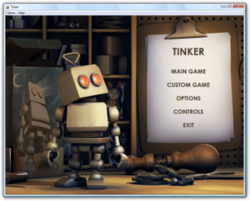Microsoft Tinker: Difference between revisions
No edit summary |
No edit summary |
||
| Line 23: | Line 23: | ||
| media = |
| media = |
||
| requirements = |
| requirements = |
||
| input = Keyboard and [[Mouse (computing)|Mouse]] |
| input = Keyboard and [[Mouse (computing)|Mouse]], [[Trackpad]], [[Gamepad]] |
||
}} |
}} |
||
'''Microsoft Tinker''' is a 60-level [[puzzle video game]] in which the player controls a [[robot]] through various mazes and obstacle courses. It was released on [[September 23]], [[2008]] as part of [[Windows Ultimate Extras]]. |
'''Microsoft Tinker''' is a 60-level [[puzzle video game]] in which the player controls a [[robot]] through various mazes and obstacle courses. It was released on [[September 23]], [[2008]] as part of [[Windows Ultimate Extras]]. |
||
Revision as of 20:19, 4 December 2009
| Microsoft Tinker | |
|---|---|
 | |
| Developer(s) | Fuel Industries |
| Publisher(s) | Microsoft |
| Platform(s) | Windows Vista Ultimate |
| Genre(s) | Puzzle video game |
| Mode(s) | Single-player |
Microsoft Tinker is a 60-level puzzle video game in which the player controls a robot through various mazes and obstacle courses. It was released on September 23, 2008 as part of Windows Ultimate Extras.
On November 10, 2009, according to Softpedia, the game will be available for download with Microsoft Hold' Em for Free for Windows 7 and Windows XP users from Games for Windows website. [1]
Basic Gameplay
Tinker is a spatial/environmental puzzle game. Players must guide a robot to an end point by moving objects, activating switches, and traversing obstacles. The playing field is a square board divided into a checkerboard pattern. The robot is given a limited number of moves it can make before it runs out of energy so the player must guide it to the goal marker without expiring all their motions. Essentially any action the robot makes counts as a move (which include walking to a square, activating a switch, and even simply turning around; wasted actions such as pushing a block into a wall also count as motions) so players must carefully plan their actions through a stage so as not to waste moves. Players can replenish the robot's energy by collecting batteries and thus extend the possible number of moves they're allowed to make (this is often necessary to collect cogs in order to completely clear a level). Players can earn the star for a level by completing the course on or under par for time, energy, and collecting all the cog wheels (if any). The playing field is littered with obstacles and movable objects that can be used to either help or hurt the robot. In addition, there are switches that can either be activated by weight, flipped by hand, or activated when a specific kind of block is pushed over it. These switches trigger a variety of effects (such as turning a laser on or off, opening or closing doors, or activating a magnet to pull a metal block). Another kind of switch is a target that can be tripped by a laser coming in contact with it (and lasers can be bounced off mirrors to alter their course in order to push them into the path of a target). There are also teleportation pads that can move objects or the robot to different places on the map. The robot is vulnerable to being hit by a laser, falling from a height greater than two blocks, getting dropped on by a moveable block or running out of power. Scoring at the end of a level is based on meeting a par value in moves left over, collectibles, and time. Completing a level at or below par value in each category earns a star and to completely clear a stage (and be given a star for the stage), all par values must be met.
